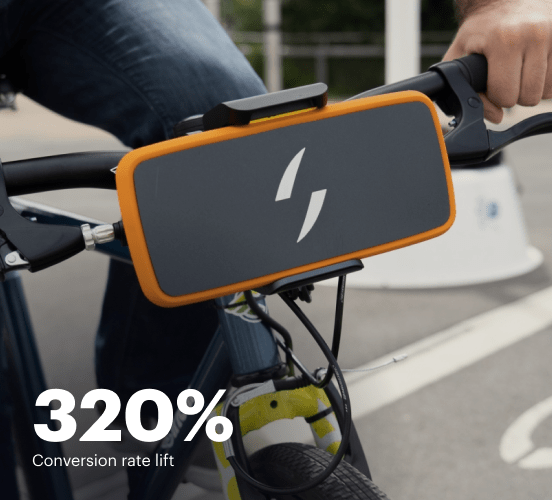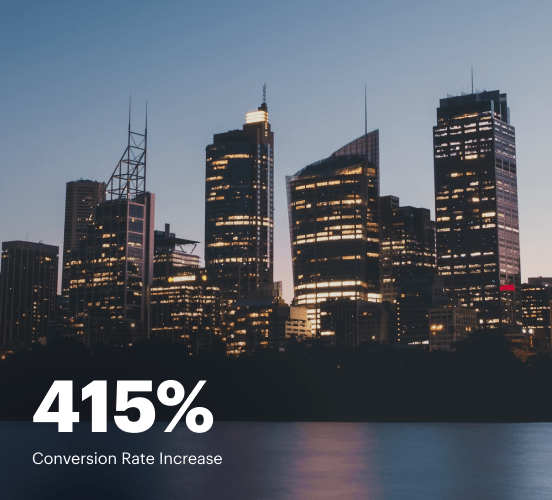How Shopify vs. Drupal vs. Instapage stack up against each other
Compare Instapage with Shopify and Drupal to create high-converting landing pages. With personalization, optimization, and collaboration tools, Instapage helps you deliver experiences that drive results.
Get startedSee how Instapage stacks up against the competition
| Feature | Instapage | Other builders |
| Drag-and-Drop Tools | ||
| Conversion-optimized templates | ||
| Manual and AI-powered A/B Tests | ||
| AI content suggestions | ||
| Popups and sticky bars | ||
| Canvas and grid blocks | ||
| Reusable and global elements | ||
| Form and popup builders | ||
| Built-in Heatmaps | ||
| Central analytics dashboard | ||
| Ad-to-page personalization and collections | ||
| Contacts, lists, and email | ||
| Dedicated, full-service CRO experts | ||
| Enterprise-ready platform |
Leading the way in building high-performing landing pages





Why Instapage is the smarter choice for your campaigns
Get everything you need to build, scale, and optimize high-converting landing pages—without coding.

Easier page building without coding
Instapage offers a flexible and seamless page creation experience with a library of 500+ conversion-focused layouts, Instablocks®, a drag-and-drop builder, and AI content generation. With technologies like Thor Render Engine®, you can create on-brand, mobile-responsive landing pages that load quickly and start converting during initial visitor clicks.

More insights — better results
Instapage lets you see in detail how each landing page experience and variation is performing so you can make targeted changes that boost page conversions. Use heatmaps for a better understanding of on-page activities, run A/B tests and AI-assisted experiments, and then track and evaluate results within robust analytics dashboards.

More personalized experiences
Instapage lets you quickly create high-performing landing pages tailored to each of your ad campaigns. Deliver personalized experiences for distinct audiences using dynamic text replacement. Effortlessly align specific advertisements to unique pages with AdMaps. Monitor audience-level metrics using our advanced data tools.

Built-in collaboration
Instapage collaboration capabilities bring your entire team together to speed up the process of landing page review, approval, and launch. No more frustrating and unnecessary revisions or edits scattered across emails. Provide instant feedback, conduct real-time page edits, and securely share your pages with outside stakeholders.

Free up time for your business
Invest time into business growth, not busy work. Launch landing pages faster with reusable forms and templates. Build once, reuse forever.
Explore all integrations






Easier page building without coding
Instapage offers a flexible and seamless page creation experience with a library of 500+ conversion-focused layouts, Instablocks®, a drag-and-drop builder, and AI content generation. With technologies like Thor Render Engine®, you can create on-brand, mobile-responsive landing pages that load quickly and start converting during initial visitor clicks.
More insights — better results
Instapage lets you see in detail how each landing page experience and variation is performing so you can make targeted changes that boost page conversions. Use heatmaps for a better understanding of on-page activities, run A/B tests and AI-assisted experiments, and then track and evaluate results within robust analytics dashboards.
More personalized experiences
Instapage lets you quickly create high-performing landing pages tailored to each of your ad campaigns. Deliver personalized experiences for distinct audiences using dynamic text replacement. Effortlessly align specific advertisements to unique pages with AdMaps. Monitor audience-level metrics using our advanced data tools.
Built-in collaboration
Instapage collaboration capabilities bring your entire team together to speed up the process of landing page review, approval, and launch. No more frustrating and unnecessary revisions or edits scattered across emails. Provide instant feedback, conduct real-time page edits, and securely share your pages with outside stakeholders.
Free up time for your business
Invest time into business growth, not busy work. Launch landing pages faster with reusable forms and templates. Build once, reuse forever.
Explore all integrationsGet started with Instapage in a few steps
-
Create your Instapage account
Start with Instapage by signing up via Google or your email. You'll get access to a free 14-day trial to discover Instapage capabilities. Feel free to cancel anytime during the 14-day trial if you decide that our product is not suitable for your business. -
Build and personalize your page
Create your first landing page from scratch or choose a template from 500+ customizable layouts. Use the drag-and-drop builder to add page elements, fonts, and backgrounds, refine content with AI, or add custom HTML, Javascript, and CSS. -
Review and make edits
Collaborate on page designs and streamline review processes. Invite your team members and stakeholders to review, edit, and provide feedback on your landing page. Collaborate knowing your page is confidential and only accessible to authorized users. -
Publish and track page performance
Publish your page to a domain or custom URL. Connect your pages to the ads you've created and track page performance within the analytics dashboard, run A/B tests and AI experiments, analyze results, and continuously optimize your landing page to maintain high conversions.
Instapage vs. Shopify vs. Drupal – Which One is Right for You?
Choosing the right landing page builder can feel like assembling an all-star team for your marketing endeavors, each contender bringing their unique strengths to the battlefield. Whether you’re looking to create captivating landing pages, streamline your e-commerce experience, or utilize a flexible content management system, your options include Instapage, Shopify, and Drupal. This article unpacks their features and advantages while helping you decide which platform aligns best with your goals while emphasizing how Instapage empowers marketers to design cost-effective, high-converting landing pages that build trust and foster customer loyalty. As we navigate through the intricacies of these three powerful tools, you'll find insights that will guide you in making an informed choice. Expect to uncover pros and cons that will help clarify the landscape of landing page construction for your business needs with this friendly comparison.
Meet the Competitors in the Digital Arena
In our corner, we have three heavyweights: Instapage, Shopify, and Drupal, each known for their stronghold in different areas of the digital landscape. Instapage shines brightly as a landing page solution designed expressly to empower marketers by optimizing conversion rates with meticulously crafted pages. Shopify, on the other hand, is the go-to e-commerce platform that excels in providing businesses with a robust online storefront alongside landing page capabilities. Finally, Drupal stands out as a powerful content management system (CMS) that offers unparalleled flexibility and scalability for complex websites. Each of these platforms boasts unique strengths that appeal to a variety of users, spanning from novice marketers to seasoned developers. With unique target audiences and functionalities, understanding these distinctions helps businesses choose the best match for their objectives.
Round One - Feature Showdown
Template Selection and Usability: Who Prepares You Best?
When it comes to template selection and overall ease of use, each player offers distinctive features. Shopify leverages its predesigned templates tailored for users aiming to enhance their e-commerce presence while maintaining user-friendliness even for those new to online retail. However, Instapage specifically excels in offering an extensive library of customizable landing page templates that are ideal for conversion-focused campaigns, allowing users to craft visually stunning and responsive pages with no design expertise required. On the contrary, Drupal provides significant flexibility with its myriad of themes and modules, but its learning curve can be steep for beginners. Users often find themselves needing more technical knowledge to harness its full capabilities. Ultimately, ease of use can be a decisive factor, particularly for those less experienced in the tech space.
Instapage: The Ultimate Companion for Customization and Conversions
Instapage positions itself not merely as a landing page tool but as an essential partner in success for marketers keen on increasing conversions. It provides unparalleled customization options through its intuitive drag-and-drop editor that enables users to build tailored pages without needing coding skills. This platform focuses on optimizing conversion rates by facilitating A/B testing, heatmaps, and analytics, allowing marketers to make data-driven adjustments effectively. Instapage empowers users to create relevant landing page experiences, ultimately increasing brand trust, customer loyalty, and conversion rates. As such, it’s not just about aesthetics; it’s about creating a meaningful connection with your audience that propels growth and revenue.
Round Two - Speed and Performance Comparison
Imagine the user experience—engaging and seamless. This round focuses on performance, analogous to the bliss of a perfectly brewed cup of coffee versus the frustration of a long wait. Fast-loading pages are essential for retaining user interest and improving conversion metrics, making speed a core component of any effective landing page. It’s safe to say that performance can make or break user engagement, much like a perfectly timed first impression.
Instapage Advantages:
- Instapage consistently delivers speedy load times for landing pages, ensuring users don't leave due to frustration.
- Advanced optimization techniques to maintain high performance even during traffic spikes.
- Built-in functionalities support AMP (Accelerated Mobile Pages) for superb mobile performance.
- Seamless integration with marketing tools guarantees swift data transfer and responsive updates.
Shopify Advantages:
- Robust infrastructure ensures fast-loading online storefront and associated landing pages.
- SSL certification boosts security and speed, enhancing user experience.
- Regularly maintained updates contribute to ongoing performance enhancements.
Drupal Advantages:
- Highly customizable with caching solutions that significantly enhance speed.
- Performance can be fine-tuned by developers to meet specific user needs.
- Scalability in handling large amounts of content without compromising speed.
When weighing speed and performance, Instapage emerges as the standout choice for optimizing landing page loading times to keep audiences engaged. While Shopify excels in maintaining robust storefronts, Drupal can be molded for speed with effort. However, Instapage’s primary focus on landing pages gives it an edge in this comparison.
Round Three - Usability and Learning Curve
Navigating through usability, each platform presents a unique learning journey. Instapage is designed for user-friendliness; even beginners find it relatively easy to master thanks to its intuitive interface. The platform provides numerous tutorials and support documentation to facilitate onboarding new users. Likewise, Shopify delivers an approachable dashboard allowing even non-technical users to launch an online store without extensive training. Drupal, although powerful, tends to intimidate newcomers with its sophisticated architecture, requiring a steeper learning curve that may discourage some. Nonetheless, developers appreciate its versatile nature once they overcome initial obstacles. All three platforms cater to various user levels; however, Instapage and Shopify stand out for creating welcoming environments for beginners.
Round Four - Support Systems to Rely On
Let's break down the customer support of each platform, visualizing them as reliable sidekicks in your landing page journey. Instapage offers a range of support options, including 24/7 chat and email assistance, extensive online documentation, and community forums where users can share solutions. Shopify similarly stands out with 24/7 support via live chat, email, and phone, alongside a vibrant community and extensive knowledge base. Meanwhile, Drupal's community-driven support, while robust in its forums, may not always provide the timely assistance a user may need due to its volunteer nature. Thus, while all platforms provide support, Instapage and Shopify generate more direct and immediate engagement.
Round Five - Exploring Pricing Structures and Plans
Discussing pricing often reveals the underlying value a platform offers. Instapage operates on a subscription basis, providing several pricing tiers that cater to various business needs. This recurring investment is often justified by the superior conversion features it delivers. Shopify, though focused on e-commerce, offers tiered pricing, which can quickly ramp up depending on the specific features a user needs to access. Drupal, being open-source, is free to use with optional costs for hosting, themes, and advanced features, making it potentially the most economical option for tech-savvy users. However, users should consider that the costs for technical support, customization, and hosting can add up. Overall, while initial pricing is essential, long-term value based on expected returns should drive the final decision.
In conclusion, while each of these three platforms offers unique strengths, your choice depends heavily on your specific needs and business objectives. Instapage excels in providing a focused solution for landing pages, ensuring high conversion rates and relevant user experiences. Shopify shines in e-commerce, ideal for those looking to establish an online business. Finally, Drupal offers extensive flexibility for those proficient enough to harness its power. It's crucial to evaluate what aspects matter most to you—whether it’s abundant features, stellar customer support, or adaptive pricing. Don't forget, a free trial or demo with Instapage can be a fantastic starting point, allowing you to explore its power firsthand.










